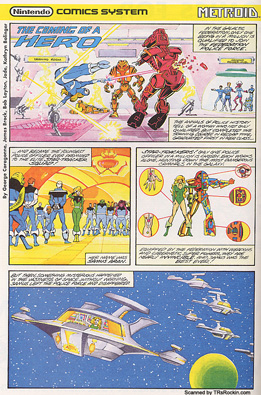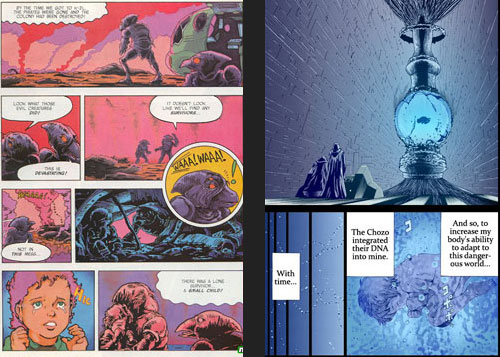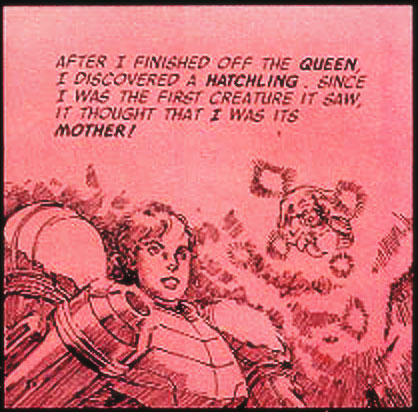Special articles, columns and features exclusive to the MDb.
Samus Aran: The Woman Behind the Visor
A Critcal Theory Essay on the First Woman of Gaming
by Infinity's End
DISCLAIMER: THE FOLLOWING IS A PERSONAL, OPINIONATED PIECE AND DOES NOT NECESSSARILY REPRESENT THOSE OF THE METROID DATABASE STAFF. --IE
The Life
 For a time, Samus's origin and backstory was shrouded in mystery. But in 1990, the two pages
described in the Nintendo Comics System story gave us a short detail about Samus's past,
telling us that she joined the Galaxy Police Force, and was the youngest to ever do so. She then
later left the force for "an unknown reason," to return as a bounty hunter. Though this piece of
information was critical in forming a story for Samus, the Captain N comics have never been
considered canon for the series.
For a time, Samus's origin and backstory was shrouded in mystery. But in 1990, the two pages
described in the Nintendo Comics System story gave us a short detail about Samus's past,
telling us that she joined the Galaxy Police Force, and was the youngest to ever do so. She then
later left the force for "an unknown reason," to return as a bounty hunter. Though this piece of
information was critical in forming a story for Samus, the Captain N comics have never been
considered canon for the series.
Four years later, when the Super Metroid comic was published in Nintendo Power, it gave insight into what Samus Aran was all about. The comic introduced a character named Old Bird, a member of the formerly-thought-extinct Chozo race. He explained that Samus was infused with Chozo blood which gave her superhuman abilities, and that they had cared for her when she was young after her home was destroyed by space pirates on a colony named K2L. Many years later, this story was reiterated on the Super Smash Bros. Melee trophy screen, and once more in the Metroid manga, making the story of Samus's origin set in stone. The manga is also considered to be official canon since it was written by the director of the Metroid series, Yoshio Sakamoto. We now know for sure about the sequence of events that caused Samus to become who she is today.

Samus's life is laden with death and revenge. After Ridley and his pirate forces destroyed the entire colony on K2L in hopes to steal afloraltite - one of the most sought-after resources in the galaxy - young Samus Aran was left to fend for herself. But after the Chozo adopted her, they were then forced to infuse her with their own blood just so she could adapt and survive to the harsh habitat of planet Zebes. In this sense, the Chozo were once again committing a very selfless act: to save a human girl's life; they were not intending to make her superhuman, they were merely trying to give her the ability to sustain herself.
A common theme in Metroid is life. Life is given by touching energy balls, life is taken away by touching harmful obstacles. Metroids drain your life, but as we all know at the end of Super, they can siphon life as well. The X-Parasite can make clones of life. Energy tanks can extend life. In Fusion, Samus even says "I owe the baby metroid my life twice over." But also unlike common gameplay conventions in many video games, you are only given 1 life in Metroid. It's this kind of gameplay design that makes Metroid unique. Sure, we can continue as many times as we want, but even though she's got this incredible array of seemingly limitless weapons at her disposal, we still feel that Samus is fragile, still mortal, and she can still die. We, as the player, can empathize with that.
 Samus is a very human, but distant character. She's much more human than Mario or Link, and is probably
the most human-looking Nintendo character. She's also female, leading us to connect with her on a much
deeper, emotional level than your average Joe-shoot-'em-up. When Samus decides not to destroy the last
surviving metroid at the end of Return, did her maternal instincts cloud her judgement? It might
be a vicious and threatening creature, but who is she to seal the fate of the species, even if it was bioengineered?
Samus is a very human, but distant character. She's much more human than Mario or Link, and is probably
the most human-looking Nintendo character. She's also female, leading us to connect with her on a much
deeper, emotional level than your average Joe-shoot-'em-up. When Samus decides not to destroy the last
surviving metroid at the end of Return, did her maternal instincts cloud her judgement? It might
be a vicious and threatening creature, but who is she to seal the fate of the species, even if it was bioengineered?










